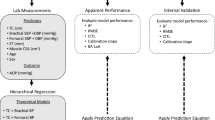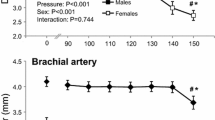Abstract
Purpose
To determine what factors should be accounted for when setting the blood flow restriction (BFR) cuff pressure for the upper and lower body.
Methods
One hundred and seventy one participants visited the laboratory for one testing session. Arm circumference, muscle (MTH) and fat (FTH) thickness were measured on the upper arm. Next, brachial systolic (SBP) and diastolic (DBP) blood pressure measurements were taken in the supine position. Upper body arterial occlusion was then determined using a Doppler probe. Following this, thigh circumference and lower body arterial occlusion were determined. Models of hierarchical linear regression were used to determine the greatest predictor of arterial occlusion in the upper and lower body. Two models were employed in the upper body, a Field (arm size) and a Laboratory model (arm composition).
Results
The Laboratory model explained 58 % of the variance in arterial occlusion with SBP (β = 0.512, part = 0.255), MTH (β = 0.363, part = 0.233), and FTH (β = 0.248, part = 0.213) contributing similarly to explained variance. The Field model explained 60 % of the variance in arterial occlusion with arm circumference explaining the greatest amount (β = 0.419, part = 0.314) compared to SBP (β = 0.394, part = 0.266) and DBP (β = 0.147, part = 0.125). For the lower body model the third block explained 49 % of the variance in arterial occlusion with thigh circumference (β = 0.579, part = 0.570) and SBP (β = 0.281, part = 0.231) being significant predictors.
Conclusions
Our findings indicate that arm circumference and SBP should be taken into account when determining BFR cuff pressures. In addition, we confirmed our previous study that thigh circumference is the greatest predictor of arterial occlusion in the lower body.
Similar content being viewed by others
Abbreviations
- Arm circ:
-
Arm circumference
- AOP:
-
Arm occlusion pressure
- BFR:
-
Blood flow restriction
- BMI:
-
Body mass index
- DBP:
-
Diastolic blood pressure
- FTH:
-
Fat thickness
- MTH:
-
Muscle thickness
- SBP:
-
Systolic blood pressure
- Thigh circ:
-
Thigh circumference
- TOP:
-
Thigh arterial occlusion pressure
References
Abe T, Kondo M, Kawakami Y, Fukunaga T (1994) Prediction equations for body composition of Japanese adults by B-mode ultrasound. Am J Hum Biol 6:161–170
Abe T, Kearns CF, Sato Y (2006) Muscle size and strength are increased following walk training with restricted venous blood flow from the leg muscle Kaatsu-walk training. J Appl Physiol 100(5):1460–1466
Acree LS, Comp PC, Whitsett TL, Montgomery PS, Nickel KJ, Fjeldstad AS, Fjeldstad C, Gardner AW (2007) The influence of obesity on calf blood flow and vascular reactivity in older adults. Dyn Med 6:4
Cook SB, Kanaley JA, Ploutz-Snyder LL (2014) Neuromuscular function following muscular unloading and blood flow restricted exercise. Eur J Appl Physiol 114(7):1357–1365
Cumming KT, Paulsen G, Wernbom M, Ugelstad I, Raastad T (2014) Acute response and subcellular movement of HSP27, alphaB-crystallin and HSP70 in human skeletal muscle after blood-flow-restricted low-load resistance exercise. Acta Physiol (Oxf) 211(4):634–646
Dupont AC, Sauerbrei EE, Fenton PV, Shragge PC, Loeb GE, Richmond FJ (2001) Real-time sonography to estimate muscle thickness: comparison with MRI and CT. J Clin Ultrasound 29(4):230–236
Fahs CA, Loenneke JP, Thiebaud RS, Rossow LM, Kim D, Abe T, Beck TW, Feeback DL, Bemben DA, Bemben MG (2014) Muscular adaptations to fatiguing exercise with and without blood flow restriction. Clin Physiol Funct Imaging. doi:10.1111/cpf.12141
Fitschen PJ, Kistler BM, Jeong JH, Chung HR, Wu PT, Walsh MJ, Wilund KR (2013) Perceptual effects and efficacy of intermittent or continuous blood flow restriction resistance training. Clin Physiol Funct Imaging. doi:10.1111/cpf.12100
Gualano B, Neves M Jr, Lima FR, Pinto AL, Laurentino G, Borges C, Baptista L, Artioli GG, Aoki MS, Moriscot A, Lancha AH Jr, Bonfa E, Ugrinowitsch C (2010) Resistance training with vascular occlusion in inclusion body myositis: a case study. Med Sci Sports Exerc 42(2):250–254
Hargens AR, McClure AG, Skyhar MJ, Lieber RL, Gershuni DH, Akeson WH (1987) Local compression patterns beneath pneumatic tourniquets applied to arms and thighs of human cadavera. J Orthop Res 5(2):247–252
Hunt JE, Walton LA, Ferguson RA (2012) Brachial artery modifications to blood flow-restricted handgrip training and detraining. J Appl Physiol (1985) 112(6):956–961
Hunt JE, Galea D, Tufft G, Bunce D, Ferguson RA (2013) Time course of regional vascular adaptations to low load resistance training with blood flow restriction. J Appl Physiol (1985) 115(3):403–411
Karabulut M, Perez G (2013) Neuromuscular response to varying pressures created by tightness of restriction cuff. J Electromyogr Kinesiol 23(6):1494–1498
Karabulut M, Sherk VD, Bemben DA, Bemben MG (2013) Inflamation marker, damage marker and anabolic hormone responses to resistance training with vascular restriction in older males. Clin Physiol Funct Imaging 33(5):393–399
Kawakami Y, Abe T, Fukunaga T (1993) Muscle-fiber pennation angles are greater in hypertrophied than in normal muscles. J Appl Physiol (1985) 74(6):2740–2744
Kooijman M, Thijssen DH, de Groot PC, Bleeker MW, van Kuppevelt HJ, Green DJ, Rongen GA, Smits P, Hopman MT (2008) Flow-mediated dilatation in the superficial femoral artery is nitric oxide mediated in humans. J Physiol 586(4):1137–1145
Koskelo EK, Kivisaari LM, Saarinen UM, Siimes MA (1991) Quantitation of muscles and fat by ultrasonography: a useful method in the assessment of malnutrition in children. Acta Paediatr Scand 80(6–7):682–687
Labarbera KE, Murphy BG, Laroche DP, Cook SB (2013) Sex differences in blood flow restricted isotonic knee extensions to fatigue. J Sports Med Phys Fitness 53(4):444–452
Laurentino GC, Ugrinowitsch C, Roschel H, Aoki MS, Soares AG, Neves M Jr, Aihara AY, da Rocha Correa Fernandes A, Tricoli V (2012) Strength Training with Blood Flow Restriction Diminishes Myostatin Gene Expression. Med Sci Sports Exerc 44(3):406–412
Lejkowski PM, Pajaczkowski JA (2011) Utilization of vascular restriction training in post-surgical knee rehabilitation: a case report and introduction to an under-reported training technique. J Can Chiropr Assoc 55(4):280–287
Levy O, David Y, Heim M, Eldar I, Chetrit A, Engel J (1993) Minimal tourniquet pressure to maintain arterial closure in upper limb surgery. J Hand Surg Br 18(2):204–206
Loenneke JP, Wilson JM, Wilson GJ, Pujol TJ, Bemben MG (2011) Potential safety issues with blood flow restriction training. Scand J Med Sci Sports 21(4):510–518
Loenneke JP, Fahs CA, Rossow LM, Sherk VD, Thiebaud RS, Abe T, Bemben DA, Bemben MG (2012) Effects of cuff width on arterial occlusion: implications for blood flow restricted exercise. Eur J Appl Physiol 112(8):2903–2912
Loenneke JP, Fahs CA, Rossow LM, Thiebaud RS, Mattocks KT, Abe T, Bemben MG (2013a) Blood flow restriction pressure recommendations: a tale of two cuffs. Front Physiol 4:249
Loenneke JP, Thiebaud RS, Fahs CA, Rossow LM, Abe T, Bemben MG (2013b) Blood flow restriction does not result in prolonged decrements in torque. Eur J Appl Physiol 113(4):923–931
Loenneke JP, Young KC, Wilson JM, Andersen JC (2013c) Rehabilitation of an osteochondral fracture using blood flow restricted exercise: a case review. J Bodyw Mov Ther 17(1):42–45
Loenneke JP, Thiebaud RS, Abe T (2014a) Does blood flow restriction result in skeletal muscle damage? a critical review of available evidence. Scand J Med Sci Sports. doi:10.1111/sms.12210
Loenneke JP, Thiebaud RS, Abe T, Bemben MG (2014b) Blood flow restriction pressure recommendations: the hormesis hypothesis. Med Hypotheses 82(5):623–626
Luebbers PE, Fry AC, Kriley LM, Butler MS (2014) The effects of a 7-week practical blood flow restriction program on well-trained collegiate athletes. J Strength Cond Res 28(8):2270–2280
Manimmanakorn A, Hamlin MJ, Ross JJ, Taylor R, Manimmanakorn N (2013) Effects of low-load resistance training combined with blood flow restriction or hypoxia on muscle function and performance in netball athletes. J Sci Med Sport 16(4):337–342
Moore MR, Garfin SR, Hargens AR (1987) Wide tourniquets eliminate blood flow at low inflation pressures. J Hand Surg Am 12(6):1006–1011
Ozaki H, Yasuda T, Ogasawara R, Sakamaki-Sunaga M, Naito H, Abe T (2013) Effects of high-intensity and blood flow-restricted low-intensity resistance training on carotid arterial compliance: role of blood pressure during training sessions. Eur J Appl Physiol 113(1):167–174
Pedowitz RA, Gershuni DH, Botte MJ, Kuiper S, Rydevik BL, Hargens AR (1993) The use of lower tourniquet inflation pressures in extremity surgery facilitated by curved and wide tourniquets and an integrated cuff inflation system. Clin Orthop Relat Res 287:237–244
Rossow LM, Fahs CA, Loenneke JP, Thiebaud RS, Sherk VD, Abe T, Bemben MG (2012) Cardiovascular and perceptual responses to blood-flow-restricted resistance exercise with differing restrictive cuffs. Clin Physiol Funct Imaging 32(5):331–337
Suga T, Okita K, Morita N, Yokota T, Hirabayashi K, Horiuchi M, Takada S, Omokawa M, Kinugawa S, Tsutsui H (2010) Dose effect on intramuscular metabolic stress during low-intensity resistance exercise with blood flow restriction. J Appl Physiol 108(6):1563–1567
Takarada Y, Takazawa H, Ishii N (2000a) Applications of vascular occlusion diminish disuse atrophy of knee extensor muscles. Med Sci Sports Exerc 32(12):2035–2039
Takarada Y, Takazawa H, Sato Y, Takebayashi S, Tanaka Y, Ishii N (2000b) Effects of resistance exercise combined with moderate vascular occlusion on muscular function in humans. J Appl Physiol 88(6):2097–2106
Takarada Y, Sato Y, Ishii N (2002) Effects of resistance exercise combined with vascular occlusion on muscle function in athletes. Eur J Appl Physiol 86(4):308–314
Thiebaud RS, Loenneke JP, Fahs CA, Rossow LM, Kim D, Abe T, Anderson MA, Young KC, Bemben DA, Bemben MG (2013a) The effects of elastic band resistance training combined with blood flow restriction on strength, total bone-free lean body mass and muscle thickness in postmenopausal women. Clin Physiol Funct Imaging 33(5):344–352
Thiebaud RS, Yasuda T, Loenneke JP, Abe T (2013b) Effects of low-intensity concentric and eccentric exercise combined with blood flow restriction on indices of exercise-induced muscle damage. Interv Med Appl Sci 5(2):53–59
Tuncali B, Karci A, Bacakoglu AK, Tuncali BE, Ekin A (2003) Controlled hypotension and minimal inflation pressure: a new approach for pneumatic tourniquet application in upper limb surgery. Anesth Analg 97(5):1529–1532
Van Roekel HE, Thurston AJ (1985) Tourniquet pressure: the effect of limb circumference and systolic blood pressure. J Hand Surg Br 10(2):142–144
Vieira A, Gadelha AB, Ferreira-Junior JB, Vieira CA, de Melo Keene von Koenig Soares E, Cadore EL, Wagner DR, Bottaro M (2014) Session rating of perceived exertion following resistance exercise with blood flow restriction. Clin Physiol Funct Imaging. doi:10.1111/cpf.12128
Weatherholt A, Beekley M, Greer S, Urtel M, Mikesky A (2013) Modified Kaatsu training: adaptations and subject perceptions. Med Sci Sports Exerc 45(5):952–961
Yasuda T, Ogasawara R, Sakamaki M, Ozaki H, Sato Y, Abe T (2011) Combined effects of low-intensity blood flow restriction training and high-intensity resistance training on muscle strength and size. Eur J Appl Physiol 111:2525–2533
Yasuda T, Loenneke JP, Thiebaud RS, Abe T (2012) Effects of blood flow restricted low-intensity concentric or eccentric training on muscle size and strength. PLoS One 7(12):e52843
Yasuda T, Loenneke JP, Ogasawara R, Abe T (2013) Influence of continuous or intermittent blood flow restriction on muscle activation during low-intensity multiple sets of resistance exercise. Acta Physiol Hung 100(4):419–426
Yasuda T, Fukumura K, Fukuda T, Iida H, Imuta H, Sato Y, Yamasoba T, Nakajima T (2014) Effects of low-intensity, elastic band resistance exercise combined with blood flow restriction on muscle activation. Scand J Med Sci Sports 24(1):55–61
Acknowledgments
The authors are not aware of any affiliations, memberships, funding, or financial holdings that might be perceived as affecting the objectivity of this manuscript. This study was not supported by any funding.
Author information
Authors and Affiliations
Corresponding author
Additional information
Massimo Pagani.
Electronic supplementary material
Below is the link to the electronic supplementary material.
Rights and permissions
About this article
Cite this article
Loenneke, J.P., Allen, K.M., Mouser, J.G. et al. Blood flow restriction in the upper and lower limbs is predicted by limb circumference and systolic blood pressure. Eur J Appl Physiol 115, 397–405 (2015). https://doi.org/10.1007/s00421-014-3030-7
Received:
Accepted:
Published:
Issue Date:
DOI: https://doi.org/10.1007/s00421-014-3030-7




